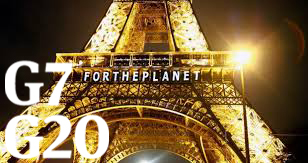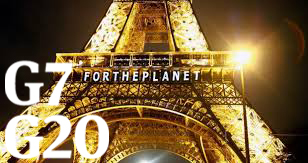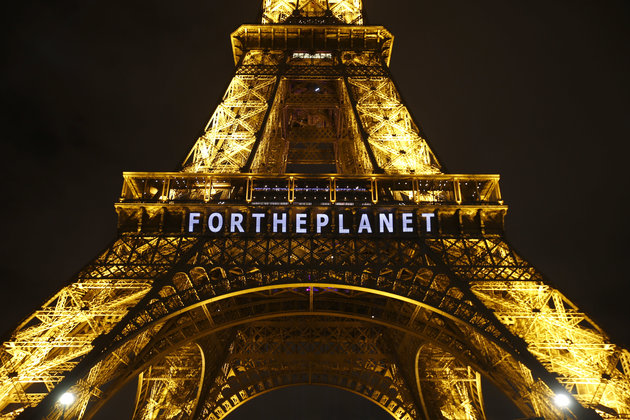Donald Bambara is a Coordinating Ambasssador for One Young World. He represented Burkina Faso at the Paris climate negotiations as a special envoy. He is a consultant in environmental sustainability and part of the UNFCCC Youth Constituency. This article originally appeared on G7G20 - the leading source of analysis and debate on the global agenda.
After two weeks of tortuous negotiations, but in reality 21 years, governments announced the Paris Agreement, the first ever legally binding climate agreement in human history.
Getting world leaders to agree can be difficult. Getting 195 of them to agree may be close to impossible. This is historic. It marks a victory for our environment, our prosperity, our public health and our security. This brand new climate deal will come into effect in 2020.
But is it really as ‘ambitious’ as is being claimed?
As the final text of the Paris deal was being built, the United Nations Framework Convention on Climate Change (UNFCCC) Youth Constituency was there to demand climate justice now and to make sure the youth voice is taken into account in every single article, because this was about us, about our future.
The increase in the global average temperature
On 12 December 2015, Parties recognised the significant gap between the mitigation pledges and what is needed to hold the increase in the global average temperature below 2°C above preindustrial levels. However, Parties have agreed to work toward 2°C above pre-industrial levels, while pursuing “efforts to limit the temperature increase to 1.5 °C”, although there is mention of what the efforts to limit the temperature to 1.5°C will comprise. This language is not concrete and illustrates a diluted commitment.
INDCs to show progress every five years
Current Intended National Determined Contributions (INDCs) lead to 55Gt of emissions in 2030, much more than the 40Gt required staying below 2˚C. Thus, each country shall communicate its progress and set a new and higher target every five years. There will be a first collective stock take in 2018 and a first global stock take under the agreement in 2023.
Good news for developing parties
Developed country parties shall continue taking the lead by undertaking economy-wide absolute emission reduction targets. Mitigation and adaptation measures will be implemented based on Common But Differentiated Responsibilities (CBDR) – an essential point for developing countries, who are the least responsible for what is happening but who are likely to suffer the most.
The absence of clarity on the future of fossil energy and its end of use in 2050
The agreement aims for greenhouse gas emissions to peak as soon as possible, yet this timeframe is ambiguous. It wants from 2050 a rapid reduction to achieve a balance between emissions from human activity and the amount that can be captured by sinks. Parties are ready to mobilise all efforts to limit the temperature increase well below 2°C, and aim to reach 1.5 °C; however they are not ready to start from now to reinforce their emissions reduction.
Climate finance – a burning point during the Paris negotiations
Parties made clear that there will be climate finance to support the transition and creation of low-carbon economies and to help communities prepare for the worst impacts of climate change. However, the terms such as new, predictable and additional have been taken out in the final text, so the nature of funds is still unclear.
What has been agreed it that developed countries will continue to mobilize $100 billion per year from 2020 to 2025 to support low-carbon growth and climate resilience in developing countries, building on the commitment from the Copenhagen Accord. By 2025, countries will set a new collective quantified goal for climate finance for at least $100 billion per year.
Additionally, developing countries are being encouraged to provide climate finance on a voluntary basis to this Global Fund. The reason is simple: many countries that were considered low-income developing countries several decades ago are now in a position that allows them to contribute climate finance for less developed countries. Countries including Vietnam and Chile have already pledged funds to the Green Climate Fund, and China has pledged $3.1 billion for South-South cooperation between developing countries.
This finance commitment helps to ensure that we are continually ramping up climate finance to assist the most vulnerable countries. In addition, to provide predictability on climate finance, developed countries will communicate every two years on projected levels of public climate finance to be provided to developing countries. Regular updates send a signal for where low-carbon investments can be made, and what resources are available to help the most vulnerable communities adapt to the impacts of climate change.
However, in reality, the billions of dollars represent just an emergency fund. It marks a brand new era, requiring a shifting of the flow of investments all over the world. There are in fact trillions of dollars that need to be mobilised to help build low-carbon and climate-resilient economies.
Capacity building
Capacity building represents a very important pillar in the fight against climate change. Indeed, the Paris text reflects support for developing countries with the launch of the 2016-20 work plan, an annual reporting system (with assistance from the Global Environmental Facility) and a review by COP24. Consistency, cooperation and planning are well reflected in the agreement. This is a huge accomplishment.
Transparency
Developed country shall biennially communicate indicative quantitative and qualitative information, including their projected levels of public financial resources to be provided; whereas for developing nations it is voluntary, which gives the latter more flexibility. However, this seems to be a fragile mechanism. Indeed, a strong Measurement-Reporting-Verification system needs to be applied systematically to all parties. The reason for this is simple: it is impossible to effectively manage what is not measured and tracked.
On a final note, let us remember that this agreement is about targets, not mechanisms. The real challenge of implementation now starts and this will require further international and regional robust agreements and implementation processes. Realising this ambition is challenging, but if nearly 200 countries can agree on the need, individually we should rise to the challenge.


